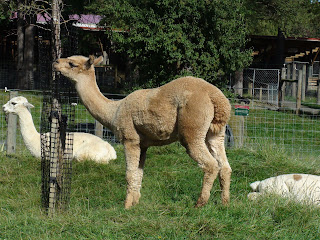Saturday, 6 March 2010 - Wednesday, 10 March
Twizel, Aoraki/Mt. Cook, and Lake Tekapo
Look at a map of the South Island of New Zealand and find Aoraki/Mt Cook, the highest peak in New Zealand. It is at the head of a large glacial valley now containing Lake Pukaki, which receives the melt water from the Tasman Glacier and Hooker Glacier. Lake Pukaki is one of three similar lakes in the region, all oriented parallel to each other, formed the same way, and all serving the same purpose. The other lakes are Lake Ohau and Lake Tekapo. Beyond the lakes to the east and south the land opens up into what is called the Mackenzie Basin, a broad, relatively flat, dry area. We spent five days in this area. Saturday night we stayed in Twizel (pron. "twaizel", not "twizzle"), drove up the valley alongside Lake Pukaki to Mt. Cook and hiked up the Hooker Valley on Sunday, and then drove on to the town of Lake Tekapo where we stayed the next four nights.
Here is the mirror-smooth Lake Pukaki. Note the reflection of the mountains in the water.
Aoraki/Mt Cook rises dramatically from the head of the Pukaki glacial valley.
The hike up the Hooker Valley was exciting. Here is a moraine lake partway up the valley. Its color is milky white from all of the fine glacial sediment suspended in it. Aoraki is not visible from this point in the valley, but it is off to the right behind the very prominent moraine ridge.
We continued the hike beyond the moraine ridge on around to the right and finally got a great view of Aoraki. This is as close as we ever got to it on the ground. To see how close we got in the air, see previous posts.
While we were in Lake Tekapo we made a couple of visits to the nearby Mount John astronomical observatory. It is sited here because the air is clear and climate is dry and nearly cloud-free most nights. It is a serious working university observatory with several telescopes, the largest of which is the 1.8-meter diameter MOA telescope.

This is the back side of the mirror. Note the many adjustable weights used to make minor corrections in the curvature of the reflector in order to perfect the image.
We were up on Mt John on a moonless night and tried to capture the star-filled sky. You will probably have to click on the following photos to blow them up. The first shows the Southern Cross and its two pointer stars.
Here is the Orion constellation above the observatory's cafe/gift shop. If you know the constellations you will notice that Orion is upside down with his sword pointing up! This is the southern hemisphere for sure.
I mentioned previously the importance of sheep dogs to the development of this country. Here is another memorial right by the lakeside in the village of Lake Tekapo.
And here is another iconic sight: Paula at the computer arranging our future accommodations. This is possibly the first vacation we have taken where we haven't planned everything out exhaustively ahead of time and secured all reservations weeks in advance. Paula has been setting it up day by day as we go along - usually 2-7 days in advance. I rather prefer travelling this way. We haven't yet set off on a day's drive with no accommodation reserved, trusting that we would be able to find something when we get there. Maybe we'll try that next. Up until now we've been travelling in the high season, since it's been summertime down here. But we're now in late March, past the equinox, which is equivalent to September in the northern hemisphere - - early autumn. The kids are back in school, and the tourist attractions are perhaps a bit less crowded, although this does appear to be prime time for foreign tourists, particularly Japanese.


















































